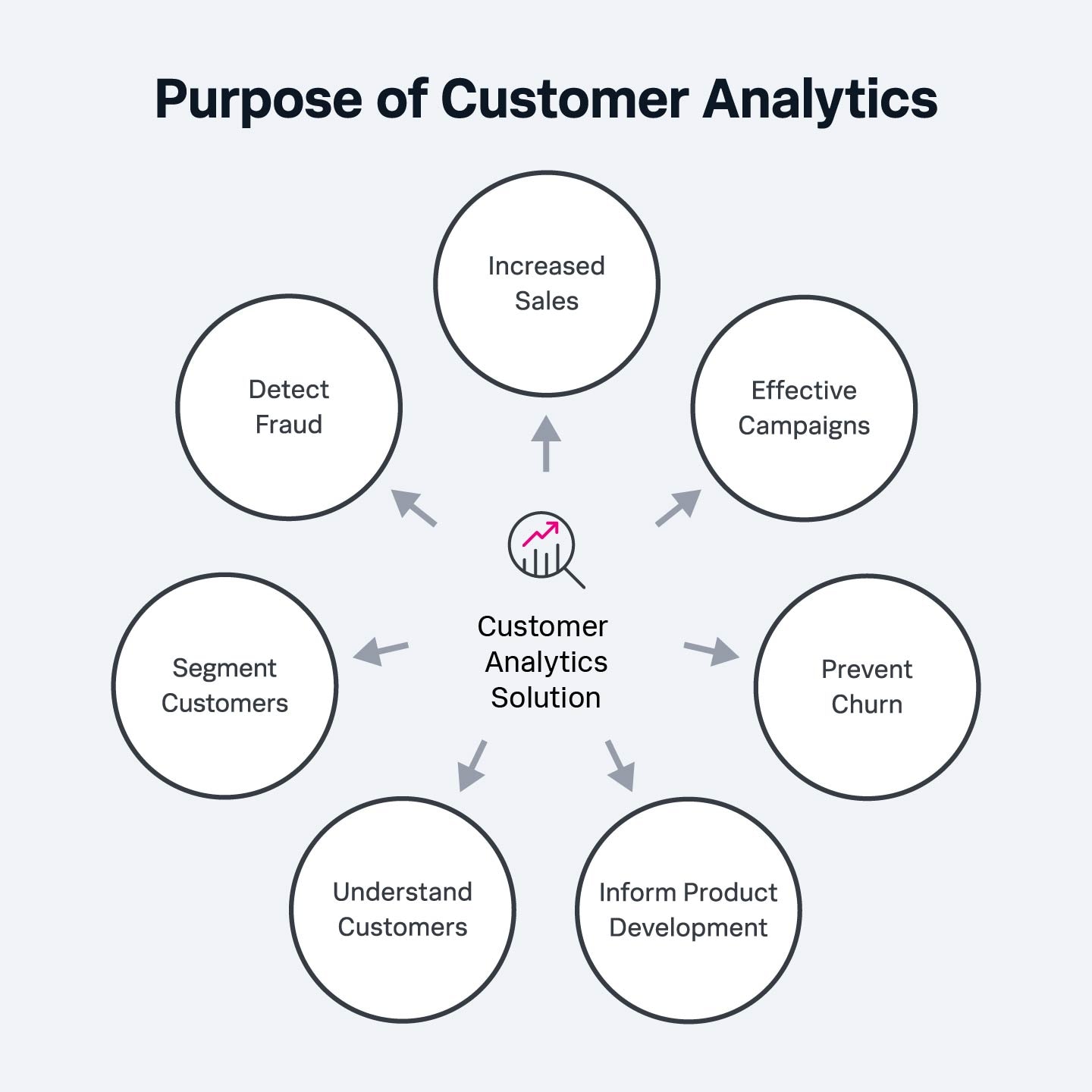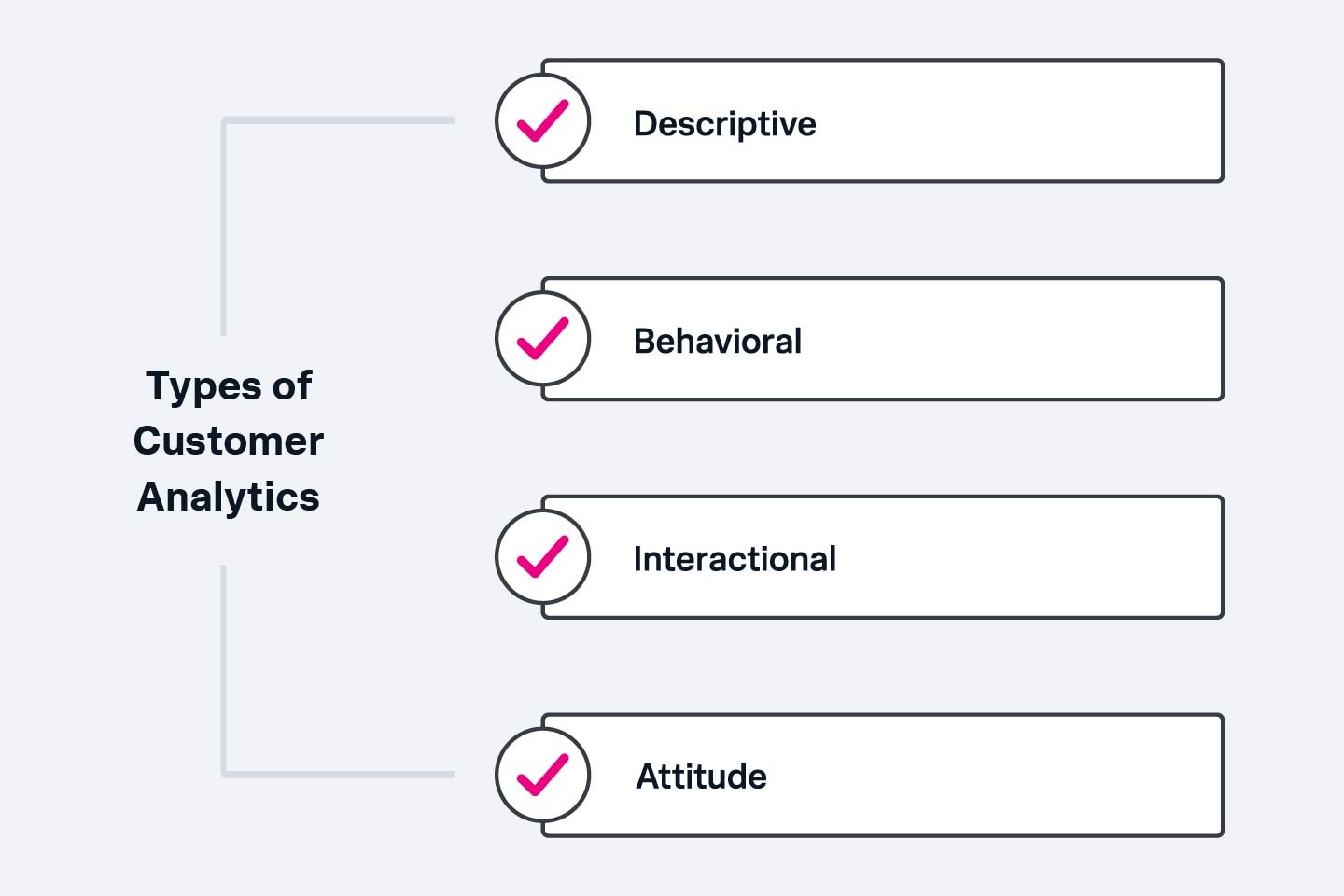 By Stephen Watts November 06, 2023
By Stephen Watts November 06, 2023
Simply put, customer analytics (or customer data analytics) is the process of using information about customer preferences and behavior to improve sales, marketing and product development.
You can think of customer analytics as the type of customer behavior where buyers are doing internet research before making a purchase. There is now a vast amount of information available for nearly every product category online. When a shopper makes a major purchase — or even a trivial one — it’s a simple matter to fire up a web browser and look up product reviews, compare prices between various stores and check after-sale support options, among other things.
While this provides shoppers with useful information, customer analytics gives businesses some level of insight into the people doing the buying. Specifically, customer analytics can answer questions around how customers find your products, how likely they are to make a repeat purchase, and whether they are likely to purchase a product enhancement (or make an in-app purchase through a mobile app.) These metrics can be used to help companies plan future products, gain customer insights, develop new strategies for reaching customers, make better business decisions and even detect fraudulent purchases.
In short, customer analytics is crucial for acquiring new customers, retaining existing ones and enhancing the customer relationship.
In this blog post, we’ll examine the ins and outs of how customer analytics works, strategies for implementing the technology and various best practices as you get started.
The Importance of Customer Analytics
Customer analytics is an important technology for any enterprise that wants to understand to whom it is marketing and selling its products or services. Customer analytics can be used to improve those customers’ experiences, increase their overall satisfaction with your brand and even lower operating costs — understanding when customers are using your services or shopping at your store can help you plan hours of operation and staffing, for example.
From lower customer acquisition costs to reduced rates of fraud to enhanced customer loyalty, savvy use of customer analytics can improve the financial outlook of a business across the board. McKinsey has reported that companies relying extensively on customer analytics have realized increased levels of profit, sales growth and ROI compared to their competitors. Per the McKinsey report, “The impact of customer analytics on corporate performance is significant — and clearly underestimated.”
While the overall goal of customer analytics is to provide a clearer view of your customer base, there are additional purposes for adopting customer analytics, such as to:
- Increase sales and customer engagement: Probably the most common use of customer analytics is for data mining, developing new ways to engage with customers, increasing the amount of time they spend on a website, in an app or in a store, ultimately increasing revenue.
- Measure the effectiveness of marketing campaigns: Are campaigns resonating with customers or turning them away? What is the customer’s purchase history? Customer analytics can provide some prescriptive answers and help organizations better understand their advertising expenses.
- Prevent customer churn: Is a customer on the verge of leaving for a competing product or brand? Customer analytics can provide advanced warning, ultimately lowering customer churn rates.
- Inform the development of new features or products: Customer analytics can provide the right data points into features or new products customers desire but which they do not yet have.
- Understand the value of a customer and customer journey: Customer analytics can help answer questions that include “How much is a new customer worth? “How much should you spend to acquire one?” And “What is needed for better customer retention?”
- Segment the customer base effectively: This improves target marketing and reduces overall expenses.
- Detect fraud: An increasingly important secondary goal of customer analytics is uncovering fraudulent transaction patterns.

Customer analytics has numerous use cases, including informing product development, understanding customers and preventing churn and detecting fraud.
Common Types of Customer Analytics Data
There are four primary types of customer analytics:
- Descriptive: This data is used to develop various personas, and includes demographics and information about a customer’s preferences toward the company and its market. For B2B customers, this could also mean firmographic.
- Behavioral: This data incorporates the way in which customers use your product, whether they shop online or offline, what device they use (computer vs. phone, for example), and even what days and times are the most popular for shoppers.
- Interactional: Primarily related to online analytics, this captures the path taken by a user who is interacting with your organization, such as the click-path on a website. It can also be used in offline settings to capture the routes taken by a shopper in a retail store.
- Attitude: With predictive analytics, you know who the customer is and how they engage with you from the above analytics; attitude data tells you how they feel. Focus groups, reviews and surveys are the common sources for this information, allowing you to quantify overall customer sentiment and how it is evolving.
Working in tandem, these four types of analytics can paint a holistic picture of an individual customer or your customer base.

Descriptive, interactional, behavioral and attitude analytics work in concert to create a holistic picture of the customer and business environment.
How it Works
In general, customer analytics is built around enterprise data collection. Fully digital companies (such as cloud-based businesses or mobile app publishers), can generate this data easier than say, a brick and mortar grocery store.
Customer analytics varies widely in its purpose and depth, and in turn varies widely in how it is undertaken. Customer analytics often starts by collecting data automatically via the use of technologies that can capture basic demographics and locations associated with a website visitor or user of an app. Then, as users work their way through a website, logs capture the route users take, how much time they spend on a page, whether they abandon a shopping cart and more. This fine-grained behavioral data can be used to determine trouble spots a customer may be having with the website, technical incompatibilities or programming bugs.
Capturing another form of customer data, users may also be polled directly about their interests or complaints they may have with the organization. Customers may also willingly and proactively provide data to the organization in the form of emails, social media posts or third-party product reviews.
After a certain amount of data is collected, some or all of this information can be combined to create a very detailed picture of an individual customer and paint a broad portrait of the business’s customers as a whole.
Customer Analytics Trends
Customer analytics is a fairly mature market, but a number of trends are impacting this industry. Here are some of the major trends to keep in mind:
- Privacy rules are impacting the way customer data is used: When Facebook and Cambridge Analytica were discovered to be grossly misusing Facebook user data in 2018, public awareness about the risks of corporate-owned user information came to a head. Response to the scandal included hefty fines, penalties, and ill will toward the companies — and increased regulatory scrutiny into the way that consumer data is captured, managed and disposed of. Today, any company that wants to engage in customer analytics needs to carefully navigate numerous regulatory compliance rules across countless global regions, while avoiding alienating the customers it is trying to better serve.
- Customer data will explode in volume: What customer is not carrying a cellphone? Or using a connected appliance? Or wearing a smartwatch that is capturing vital statistics in real time? All of these tools are potential sources of data which, with the user’s permission, are being mined to offer targeted advertisements, value-added services and product pitches. As the volume of customer data is compounded through additional technologies like internet of things devices, smart enterprises will gain new data-driven insights and figure out additional ways to leverage this deluge of information.
- Customers will continue to engage the business through multiple methods: For customers of, say, a traditional bank, it’s not uncommon that the customer will engage with it in person, via an automated device like an ATM, on the web, over the phone and via a mobile app. The business will need to ensure that it can reconcile and unify each of these contact points into a single, holistic view of a customer — while ensuring that its customer service on all of these fronts meets expectations.
Common Use Cases
While each organization will use customer analytics in its own unique way, here are some of the most common questions that customer analytics is used to answer:
- Are my customers happy? Measuring customer satisfaction is a foundational goal of customer analytics.
- What is the value of customer interactions over their lifetime? Understanding how much a given customer contributes to the top and bottom line of the business helps in planning marketing expenses as well as customer acquisition outlays.
- Are customers loyal to my business? What is the likelihood of a customer defecting to a competitor — and what would prompt them to do so? (Or prevent them from doing so?)
- How effective are my sales efforts? What sales channels are resonating with customers, and how is that changing over time? How can overall sales levels be improved?
- What is the social media sentiment toward my organization? More and more customer activity is taking place on third-party social media sites, which are difficult to analyze without a formal customer analytics program.
- Is my website/app functional? Customer analytics can help you surface technological holes in your operations or trouble spots that are interfering with the user experience.
- Are customers abandoning shopping carts? And if so, where and why?
- Is customer support performing well? Customer analytics can help determine if support agents are working as expected, and how their level of support is changing. Over time, most organizations set goals to improve support levels while decreasing the need for support.
- Are upsell opportunities available? The most profitable way to increase customer revenue is often to sell more to an existing customer rather than acquire a new one.
Getting Started With Customer Analytics
Most organizations find themselves implementing customer analytics in some fashion whether they fully intend to or not. After becoming familiar with the technology through free tools like Google Analytics, the next step is to formalize the customer analytics program.
Typically this begins by choosing a customer analytics platform, leveraging machine learning and/or predictive modeling that aligns with the type of business and offers the key features and integrations needed by your organization. In most organizations, a dedicated product manager or data scientist will be useful for running analyses and interpreting results. This staff member can help answer strategic questions about what data sets are important to capture, how to design A/B tests, and what sales channels the organization should focus on. (In today’s marketplace, an omnichannel approach is common, in which mobile, online, physical retail and other consumer touchpoints are considered together.) Your customer analytics manager will also be responsible for making active predictions about how customers are likely to behave in response to new products or services as well as creating surveys, helming focus groups, interacting with other customers and providing actionable insights.
Customer Analytics Software/Solutions
Most enterprises already use some form of customer analytics, even if they don’t actively know it. Free, off-the-shelf tools like Google Analytics are extremely popular, giving you a base level of insight into customer segments and the way customers interact with your website. Because the basic tool is free, it provides a convenient, no-risk gateway for organizations wishing to dip their toe into customer analytics tools — at least as it relates to the web. Your CRM tool is another natural source for customer data that you’re already using.
There are a number of standalone options when it comes to customer analytics, but the market is relatively fragmented, feature sets can vary widely and not all tools are directly comparable. This list represents some of the most widely used and best reviewed customer analytics tools.
- Adobe Analytics: A broader business intelligence tool for analyzing the web-based customer journey.
- Glassbox: A platform designed to analyze behavior during individual web and mobile app sessions.
- Kissmetrics: A web analytics platform with separate products for tracking SaaS and e-commerce operations.
- Mixpanel: This self-described product analytics tool has dozens of connections to third-party add-ons to enhance functionality.
- ContentSquare: This customer analytics tool reveals why users behave in certain ways.
The Bottom Line: Know your customer to know your business
Few would argue with the concept that the customer comes first, so it makes sense that you’ll need to understand everything you can about the customer lifetime value as you operate your business. The days of Henry Ford’s position that customers could have any color Model T they wanted “so long as it is black” are long behind us. Customers today demand personalized, high-quality services and products, and it is easier than ever for them to defect to competitors if your company is not meeting those demands. One-size-fits-all solutions are rarely effective today. To succeed in the market, smart organizations are using customer analytics to truly understand the tastes and desires of their clientele, then using those insights to design customized solutions that specifically meet their needs.
What is Splunk?
This posting does not necessarily represent Splunk's position, strategies or opinion.
